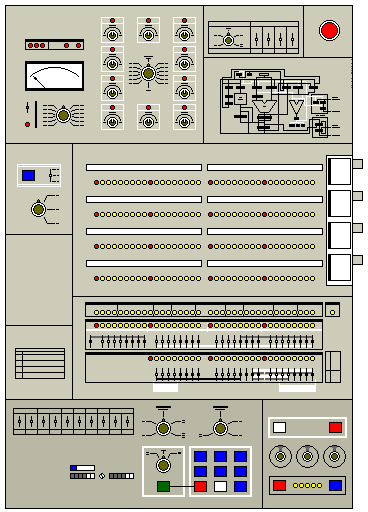
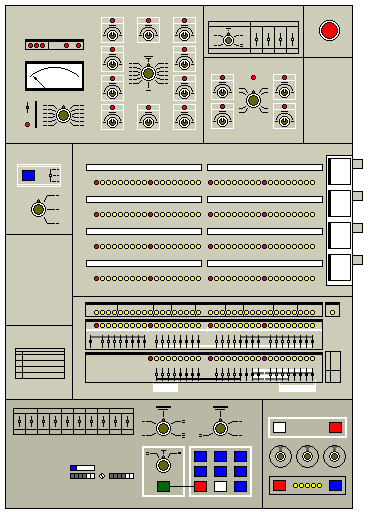
Prior to Tuesday, April 7, 1964, the day of the announcement of System/360, IBM was the world's largest and most prominent manufacturer of computers. Its rise to prominence in this field is generally acknowledged to have taken place as the result of the success of the IBM 704 computer.
This was a vacuum-tube computer with hardware floating-point capability. It had a word length of 36 bits, and its architecture was used, with extensions, in the later vacuum tube 709 and the transistorized 7040, 7044, 7090 and 7094 computers.
Before it had even entered the computer field, International Business Machines was the dominant supplier of punched card accounting equipment. An IBM 407 accounting machine contained both a card reader and a line printer, and would print reports from a card deck read in by it under the control of wiring in a plugboard. Thus, such equipment, in addition to having the ability to calculate automatically, embodied the functionality of what were to be common mainframe computer peripherals.
In 1949, IBM began offering the Card Programmed Calculator. This device was inspired by a creative use of IBM accounting equipment at Northrop. It could read cards which controlled the choice of sequences of calculations from plugboards, and was used as an automatic calculating machine by many firms that were not able to afford a computer.
The Harvard Mark I relay computer, a very important early computer, as it brought the idea of a computer to the attention of the world, was made with the support of IBM.
IBM later made the Selective Sequence Electronic Calculator; it used a paper tape derived from the 80-column card as its memory, limiting its speed and flexibility as compared to stored-program computers, but it did perform calculations electronically with vacuum tubes. It had an imposing and futuristic appearance, and it inspired, for example, cover paintings on science-fiction magazines. It was a one-of-a-kind machine, and its use was made available on a service bureau basis.
The first computer IBM manufactured as a product was the IBM 701 computer; it was the predecessor of the IBM 704, working on 36-bit integer operands in a Williams tube random-access memory with 18-bit instructions. It was also called the Defense Calculator; the impulse to build it came from the needs of the U.S. military, and IBM was initially slow to anticipate the demand of the private and academic sectors for computing power.
The IBM 701 and the 704 were similar in appearance, although the 704 had a much more sophisticated instruction set. Both did their computations in binary.
IBM also made many machines that did their work with numbers in decimal form; the IBM 702, like the 701, an early Williams tube machine, the IBM 705, which superseded it, and the 7080, the transistorized version of the 705, the IBM 650, an inexpensive vacuum-tube drum machine, the IBM 1620, an inexpensive transistorized machine which, while decimal, was aimed at scientific users.
The most popular IBM computer, before the arrival of System/360, was the IBM 1401 and its relatives (the 1410, 1420, 1460 and 7010).
The IBM 7070, 7072 and 7074 computers were transistorized mainframes that could be used for either scientific or commercial processing; arithmetic was on packed decimal numbers in a fixed word length. Hardware floating-point was available for it as an option. Scientific users preferred binary machines, and commercial users held out either for the 7080 or for either 7010 or one of its relatives. (The 705/7080 architecture and the 1401 architecture were different in a number of ways, but both machines did their arithmetic on decimal numbers of variable length stored as character strings, then called zoned decimal numbers as distinguished from decimal numbers stored as four-bit BCD digits, called packed decimal numbers.)
As IBM was the largest computer company of the time, its production of any one architecture in its line-up was still as large as the entire computer production of many of its competitors. Even so, the multiplicity of incompatible designs in production at the beginning of the 1960s prompted investigation of the possibility of a computer architecture that could serve the differing needs of all of IBM's computer customers.
The System/360 architecture was the result. Its core instruction set handled 16-bit and 32-bit binary integers. One optional feature allowed the handing of variable-length packed decimal numbers, and another added the ability to handle binary floating-point numbers. Thus, a machine for exclusive scientific use and another one for exclusive commercial use would not have an identical instruction repertoire, as users purchased only the capabilities they needed, but a machine with both features could be upwards-compatible with both.
This was one of two things that were required to make the System/360 a computer for everybody. Some customers would need large, powerful computers, while others needed small, inexpensive ones. So that computers of different sizes could still have the same instruction set, IBM made extensive use of microcode in implementing the various System/360 processors.
The original System/360 machines were made from integrated circuits, unlike the previous machines which used discrete transistors. In 1964, monolithic integrated circuits were available, but they were not yet competitive with transistors. IBM's large size made it possible to use an intermediate technology which it called solid logic technology (SLT), where single-transistor chips, instead of being packaged individually to make transistors, were bonded to a substrate mechanically.
On April 7, 1964, IBM initially announced the following models of System/360: models 30, 40, 50, 60, 62, and 70. Model 62 was the same computer as Model 60, but with faster memory. Later changes in the specifications of the later units in the series led to their designations being changed, and so IBM's initial System/360 processor lineup as delivered actually consisted of models 30, 40, 50, 65 and 75.
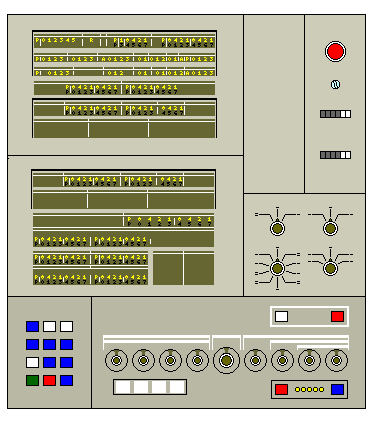
The Model 30 was the entry-level machine in IBM's initial System/360 lineup. It had a data bus to main memory that was eight bits wide, and its main ALU was also an eight-bit ALU. The machine's registers were stored in regular main memory.
Microcode was made up of words 50 bits in width. Note that the widths of microcode words as given include parity bits. It used a capacitative read-only memory, with microde bits encoded as holes in special layered cards having the same dimensions as normal 80-column punch cards, which was twice as fast as main memory.
This front panel closely resembles in its general layout that of the Model 22, the last System/360 model to be introduced, which was based on its design, but that computer's front panel was still different in appearance, as it had conventional lamps on the front instead of legends backlit through an overlay.
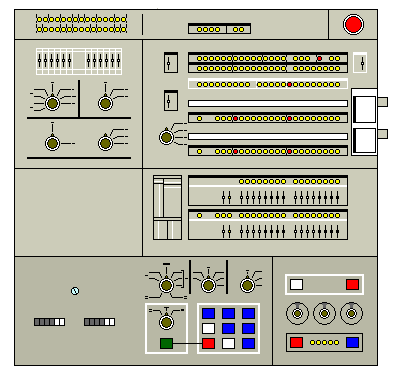
The Model 40 was the most popular member of the initial System/360 lineup. It also had an eight-bit ALU, but the path to memory was 16 bits wide. Registers were stored in special fast core with twice the speed of main memory.
On this machine, microcode words were 56 bits wide. Transformer-wound wires were used for microcode, with a cycle time four times that of main memory.


The Model 50 had a 32 bit ALU, and a 32 bit data bus. Registers were stored in special fast core with four times the speed of main memory.
Microcode words were 88 bits long, stored in a balanced-capacitor memory also four times as fast as main memory.
This model had an unusual section of its front panel displaying the flow of data in its main processing portion. Additional controls for adjusting some of the processor's internal voltages, however, replaced this section when additional memory was installed, as I have recently been informed.
Because of this significant variation in this model's front panel design, both variants are illustrated.

The Model 65 had an ALU that was 60 bits wide, allowing it to handle in a single operation the fraction from a double-precision floating-point operation; a separate 8-bit ALU was used either for the exponent of a floating-point number, or for character and packed decimal operations. The bus to main memory was 64 bits wide. It also used a type of main memory that was twice as fast as that used with the smaller models in the series. Registers were stored in flip-flops to achieve four times the speed of this faster main memory.
Microcode words were 100 bits long, stored in a balanced-capacitor memory four times as fast as this computer's faster main memory.
The later Model 67 computer has basically the same front panel, it being the same computer but with Dynamic Address Translation hardware added to facilitate timesharing.
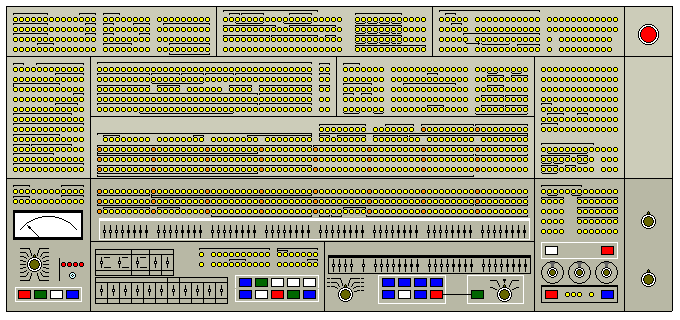
The Model 75 computer used the same main memory as the Model 65, and also stored its registers in flip-flops four times as fast as main memory.
The control logic of this computer was hardwired rather than microcoded. It had originally been planned to use microcode for this model as well, but it was not possible to make a microprogram store fast enough to provide the performance desired.
The width of this front panel caused it to be placed on what might be considered the right side of the processor cabinets if the typical location for a System/360 front panel, as used for the models illustrated above, is considered to be the front of the processor cabinets.